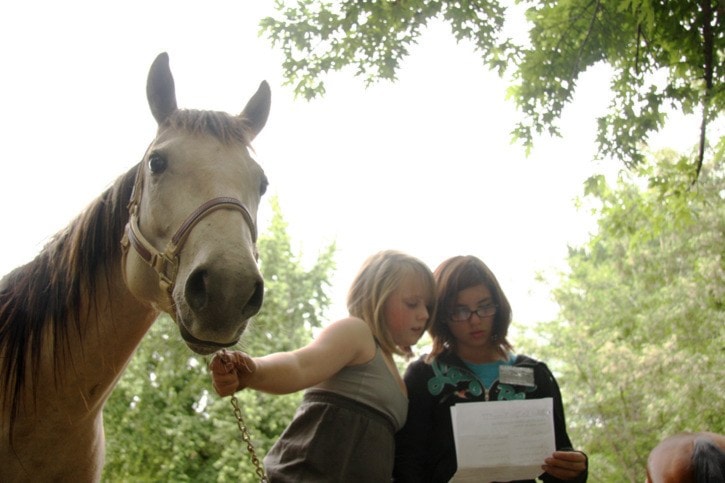As students wrap up final exams and get ready for summer, one last graduation of a different kind was held last Wednesday night.
The first grads from the Equine Assisted Learning (EAL) program at Harding Heights Ranch accepted their certificates along side classmates of both the two and four-legged type.
The program aims at teaching students different life skills while developing healthy relationships, leadership, confidence and self-esteem, among other things, using horses and their behavior as teaching tools in team-focused exercises.
“Honestly, at the beginning of this program I really didn’t want to be here,” said Cody Sloot, who was enrolled in the program with his brother.
“My mom told me about it and said it was really fun, but I was thinking, ‘you’re going to be around horses the whole time but you don’t get to ride them — that doesn’t sound fun at all.’
“But then I got here and after a couple of times it was actually really fun, I enjoyed it and I started to look forward to it more — it’s taught me how to be a bit more of a leader.”
“It gets the learning experience out of the conventional box and increases the effectiveness of whatever it is you’re trying to learn,” explained Leah Hope, EAL facilitator.
One exercise involves two students each holding a lead rope with one hand, weaving the horse through pylons inside a U-shape set of rails with the objective of turning the horse around at the end of the course and coming back.
The only “rules” are that the horse can’t step over the rails, students can’t step inside the rails, and they are only allowed one hand on a rope at a time.
After some pretty creative attempts at turning the horse around, eventually students picked up on what the horse was trying to show them — just because he couldn’t step over the rails, that didn’t mean he couldn’t walk through the holes between them in order to turn around.
Voila — “outside the box” moment.
Although EAL generally targets at-risk youth and aboriginals its benefits can extend into corporate and community settings.
The kids benefit from learning experimentally and deriving their own conclusions about the exercise; which translates into making judgment calls going into life, Hope added.
“It’s a trickle-down effect — we have to invest in our communities, especially in the communities where the kids are dropping through the cracks because they’re going to be our future leaders and workforce.”
When asked why the ranch decided to hold EAL classes, Shauntelle LeRose, co-owner of Harding Heights, said it was a personal decision.
“Between her (Hope) and I we know how much the horses have taught us and thought this was a great program to bring to the kids in the area,” she said.
The pilot program was a great success, with not only program facilitators seeing personal growth within the kids but parents as well.
Sloot’s mother, Lisa, said she enrolled her boys because of personal circumstances the family was dealing with. Neither boy wanted to attend, and she said the first session neither of them said a single word.
But by the second session, their tunes changed — both boys admitted they enjoyed what they were doing and started to apply what they were learning to their daily lives.
“They’re more settled — it’s like a break from the world and everything that’s going on to just come out here and enjoy the horses,” she said. “It’s been really good.”
“It’s awesome to get the feedback from parents — we see the feedback instantly here but then the kids leave and it’s nice to get that from parents that they’re noticing the differences in the kids,” said Hope. “Ultimately if what they take here goes out into their world at home and at school then we’ve had success.”
For more information on the EAL summer and fall programs at the ranch, visit their website.
